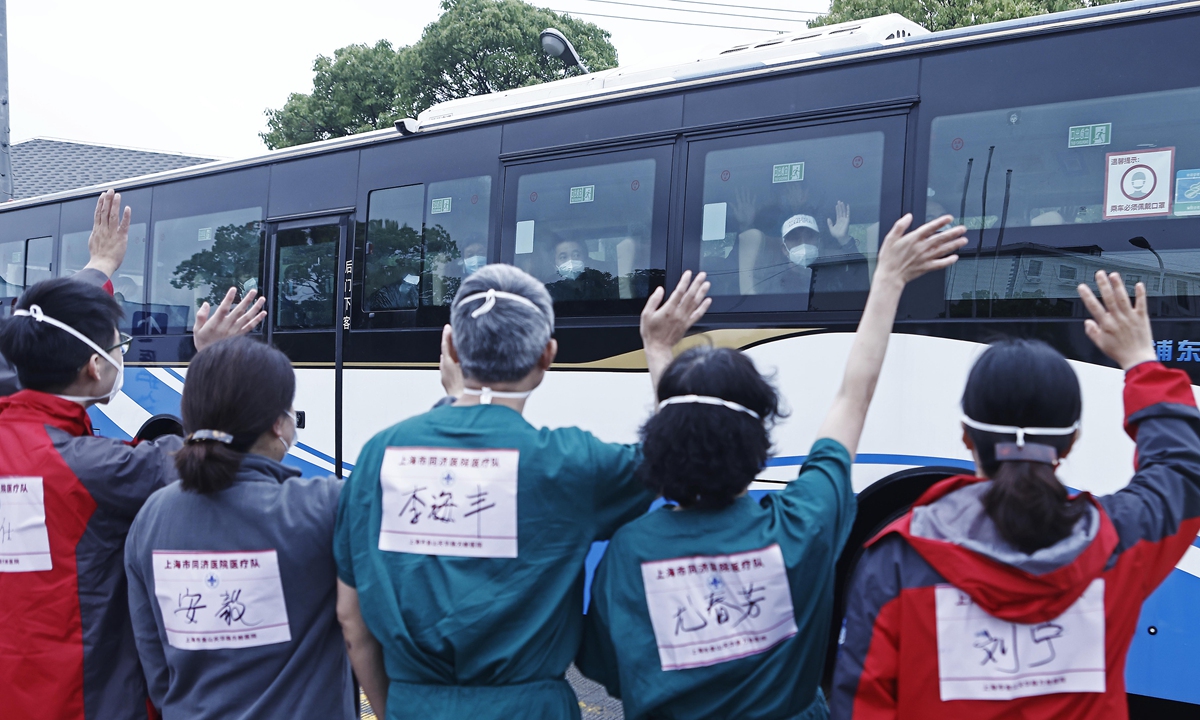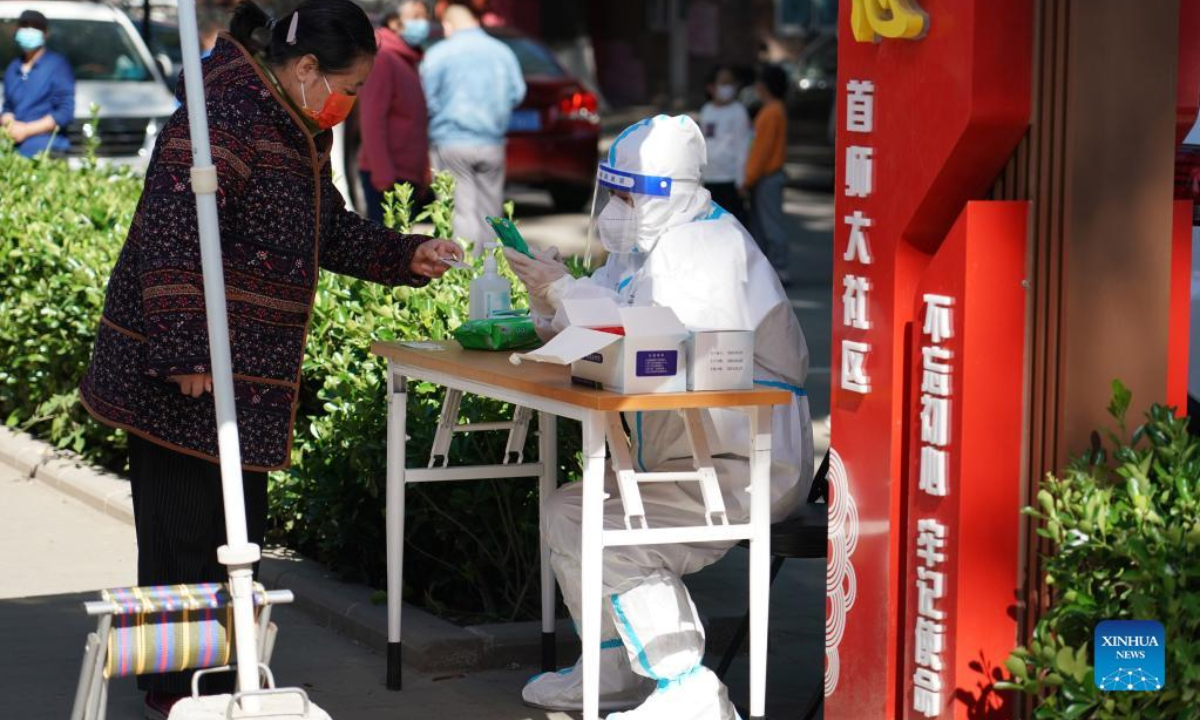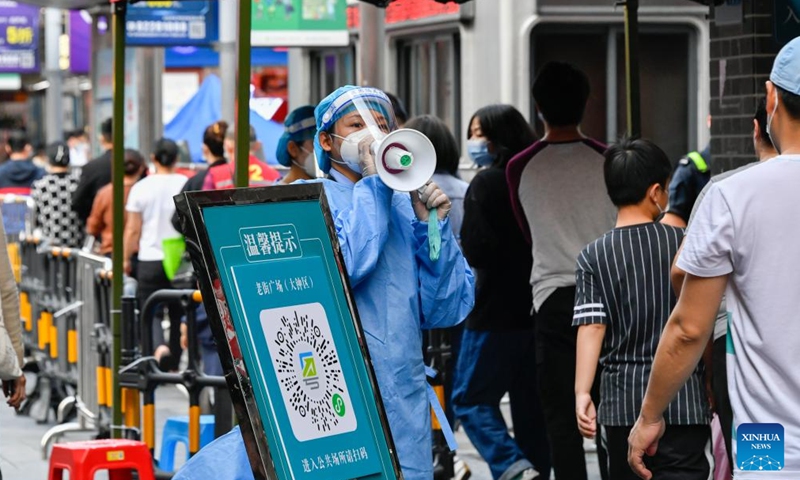
Members of a medical team wave to discharged patients at Tongji Hospital in Shanghai, May 13, 2022. The last batch of 172 patients discharged from a makeshift hospital in Jinshan District of Shanghai recovered that day. Photo: cnsphoto
The construction of a 15-minute circle of nucleic acid testing services in big cities would help to speed up China's response to COVID-19 outbreaks, a national health official said Friday, as the country has gradually fished out a Chinese method to fight the rapidly spreading Omicron variant while epidemic-stuck cities like Shanghai and Beijing are seeing declining infections.
Shanghai aims to reach the goal of reporting zero new COVID-19 cases at the community level by mid-May and social life including public traffic, shops and schools will resume gradually in an orderly manner, Shanghai Executive Vice Mayor Wu Qing said at a press conference on Friday.
Shanghai on Thursday reported 227 local COVID-19 cases and 1,869 asymptomatic carriers, representing the 10th consecutive day to report fewer than 5,000 cases, according to health authorities.
The city has also been planning how to consolidate the hard-fought results as well as to resume normal social life in an orderly manner.
It has been planning to build 9,900 COVID-19 testing booths within a 15-minute walking distance as regular negative nucleic acid results will be needed for social activities such as work and shopping, according to Shanghai authorities.
Among the planned 9,900 booths, 5,700 sites have been put into operation, with its daily testing capacity reaching more than 8 million tubes, as of Thursday night.

A medic takes a swab sample from a resident for nucleic acid test at a community in Haidian District of Beijing, capital of China, May 13, 2022. Photo:Xinhua
Beijing has also been enhancing local nucleic acid testing services during the latest outbreak, which had led to 979 confirmed cases as of 3 pm Friday.
Beijing has also required residents to show negative nucleic acid testing results when entering public places since Thursday. The capital kicked off consecutive mass nucleic acid testing from Friday to Sunday in 12 districts as a bid to curb transmissions as soon as possible.
Wu Zunyou, chief epidemiologist with the Chinese Center for Disease Control and Prevention, said on Friday on China’s Twitter-like Sina Weibo that there is a low possibility that the outbreak in Beijing could escalate into a large-scale epidemic due to the quick and strong response measures.
The Global Times found that about 20 cities and their counties across China have launched a round of mass nucleic acid testing on Friday to reduce the risk of virus transmissions, including Wuxi and Suzhou in East China's Jiangsu Province that are near Shanghai.
Other major cities like South China's Guangzhou, Central China's Zhengzhou, and Northwest China's Xi'an also conducted mass testing to screen out possible infections. Based on conservative estimates, over 50 million residents have undergone testing in a day.
Facing the Omicron variant that had swept some major Chinese cities, nucleic acid testing is still the most effective tool to find the infections as soon as possible, an expert from the Chinese disease prevention and control system told the Global Times on condition of anonymity.
As outbreaks continue to emerge nationwide, regular testing has enabled the city to detect new cases in the shortest possible time and stem these more quickly. And if we can identify an outbreak at its initial phase, there is no chance that it will develop into a major flare-up, experts said.

A volunteer in protective gear guides citizens at a nucleic acid testing site in Luohu District of Shenzhen, south China's Guangdong Province, March 13, 2022.Photo:Xinhua
The idea of establishing a 15-minute circle of testing services stems from on-the-ground experience in Shenzhen, Guangdong Province, which successfully contained dozens of Omicron infection clusters and prevented major resurgences.
It has become a vital basis for China to fish a Chinese method to make a quick response to the epidemic and put it under control within the shortest period while maintaining a balance between economic development and reducing the impact on people's daily lives.
The construction of the 15-minute circle would facilitate the public and help to screen out infections as soon as possible. Hangzhou and Shenzhen have been actively promoting the issue, Guo Yanhong, an official from the National Health Commission, said at the Friday press conference.
Guo noted that China's nucleic acid testing ability has largely improved in the past two years. With 13,000 medical institutes and 153,000 professional personnel, China is now able to test 57 million tubes of nucleic acid samples per day, according to Guo.
As part of the Chinese method to fight Omicron, Chinese authorities are also shortening the period epidemic areas are put under control and that of centralized quarantine based on the characteristics of the variant.
For example, Beijing has shortened the centralized period for close contacts from 14 days to 10 days plus temporary management measures in related areas, which would be lifted as soon as transmission risks are ruled out after quick mass nucleic acid testing, Wu Hao, an expert at the National Health Commission's Disease Prevention and Control Advisory Committee, said at the Friday press conference.






